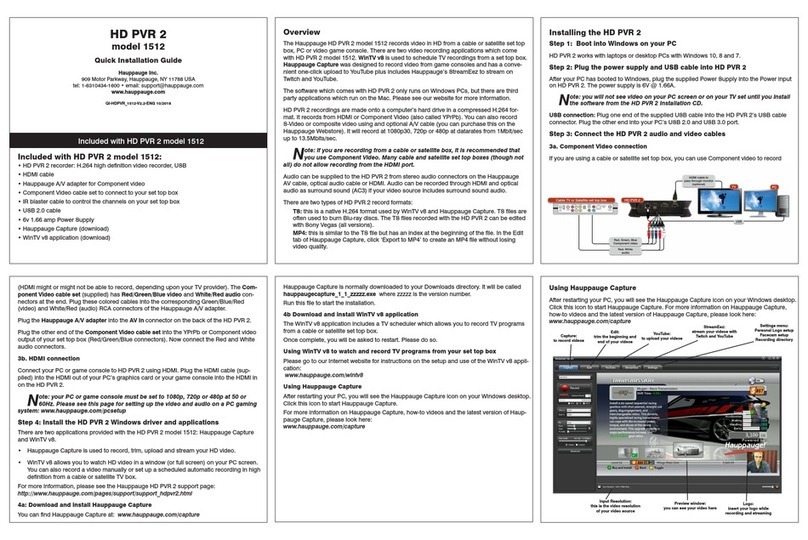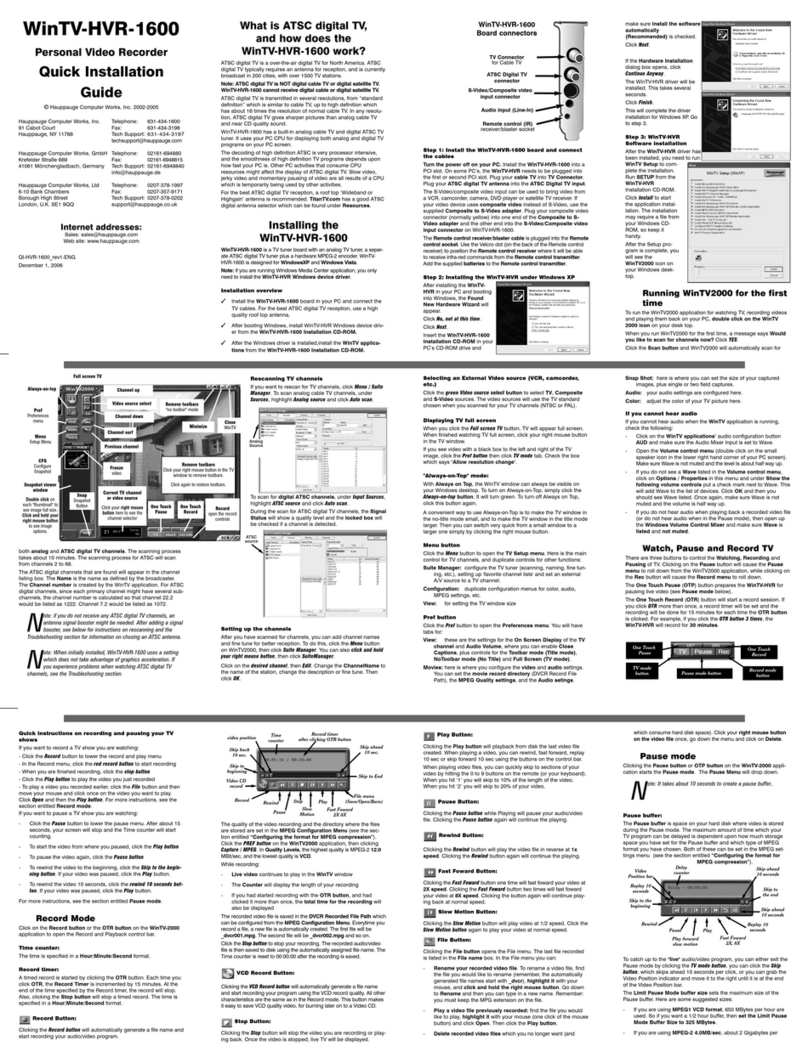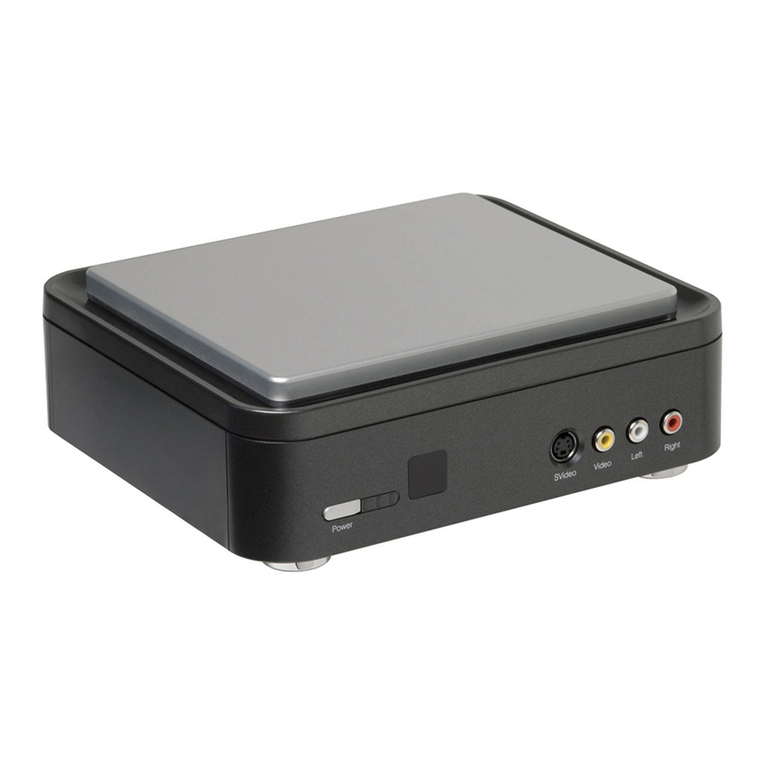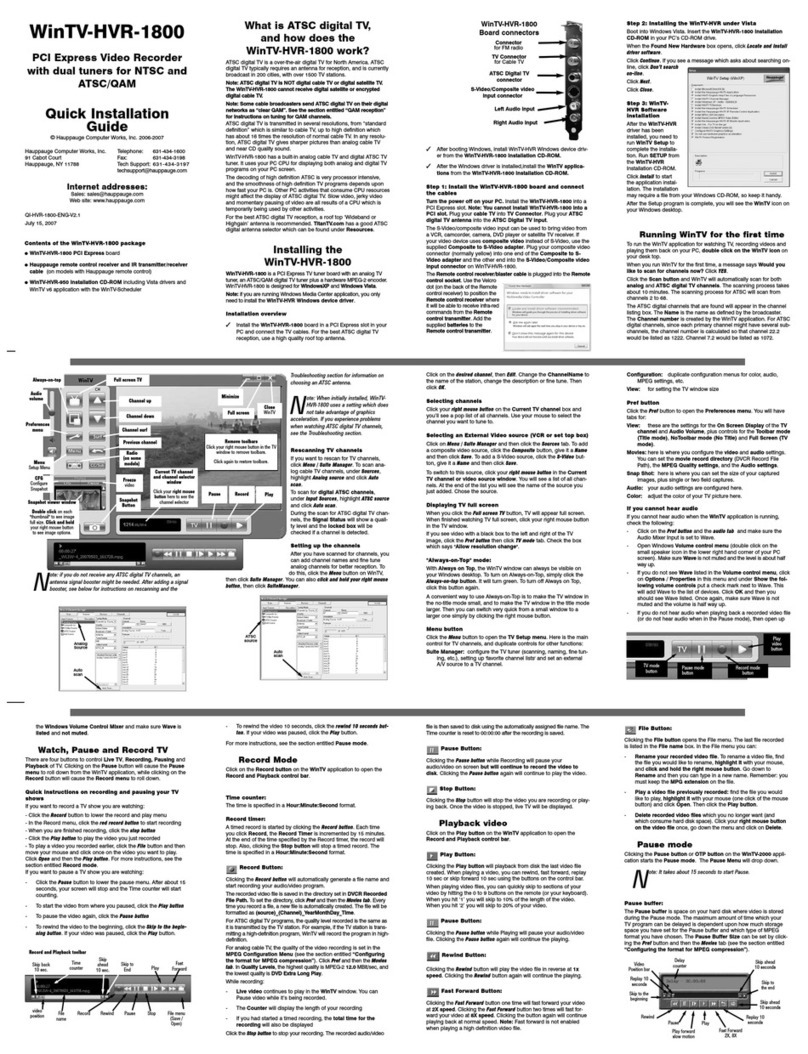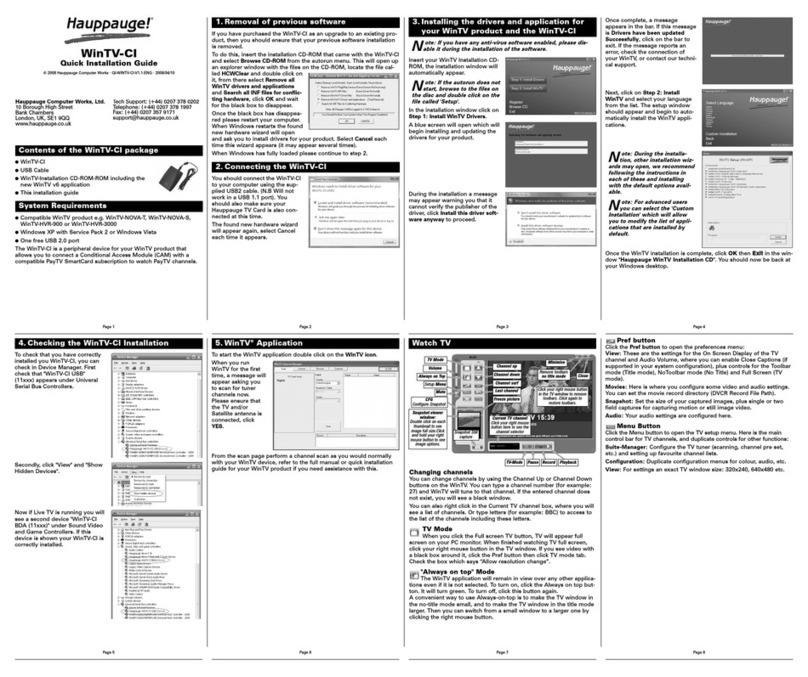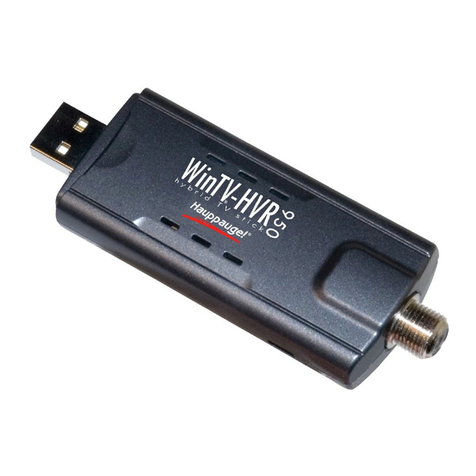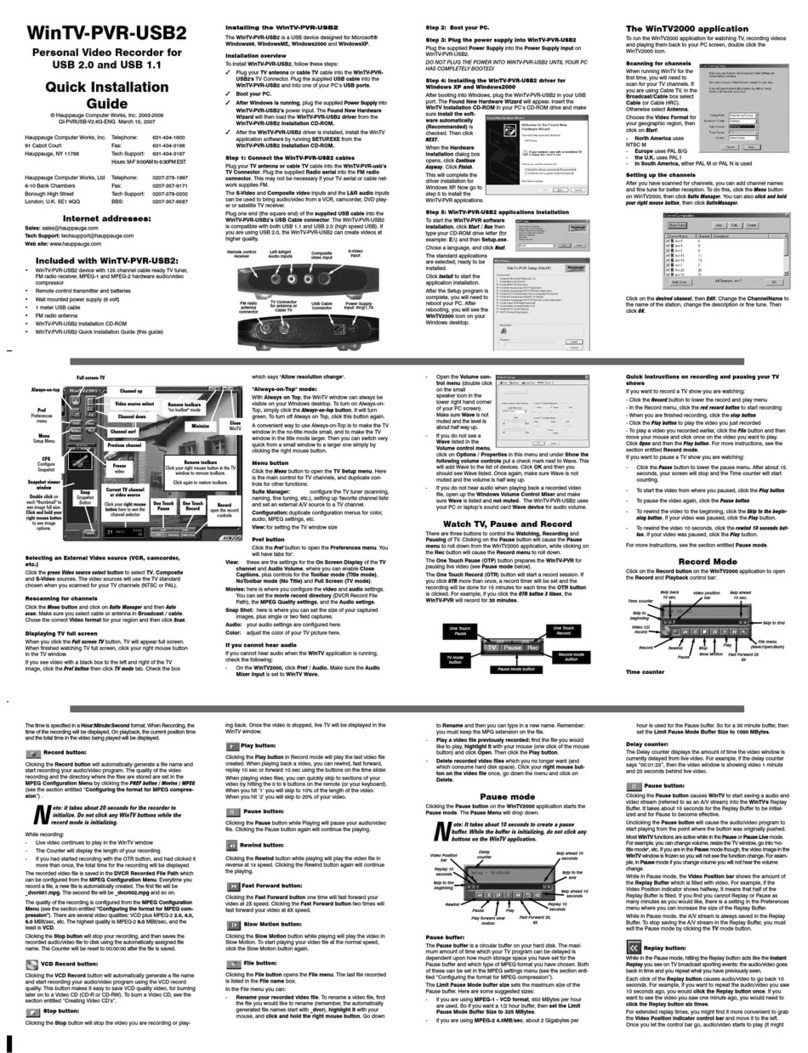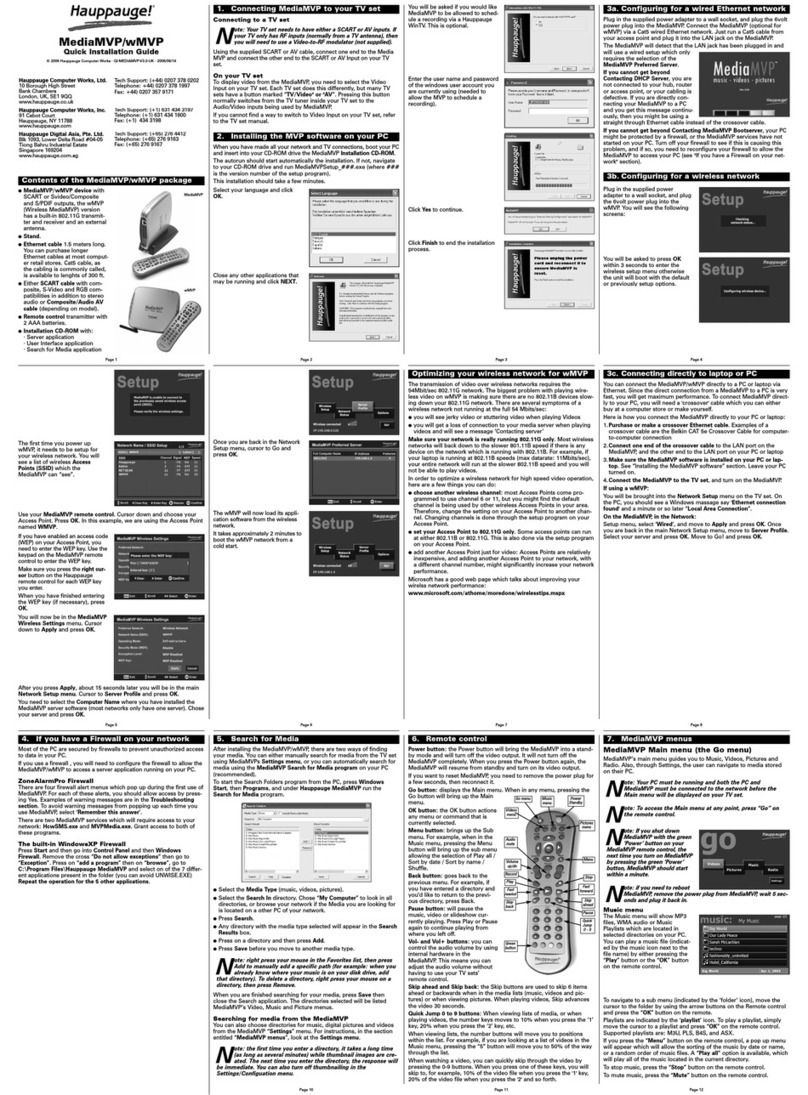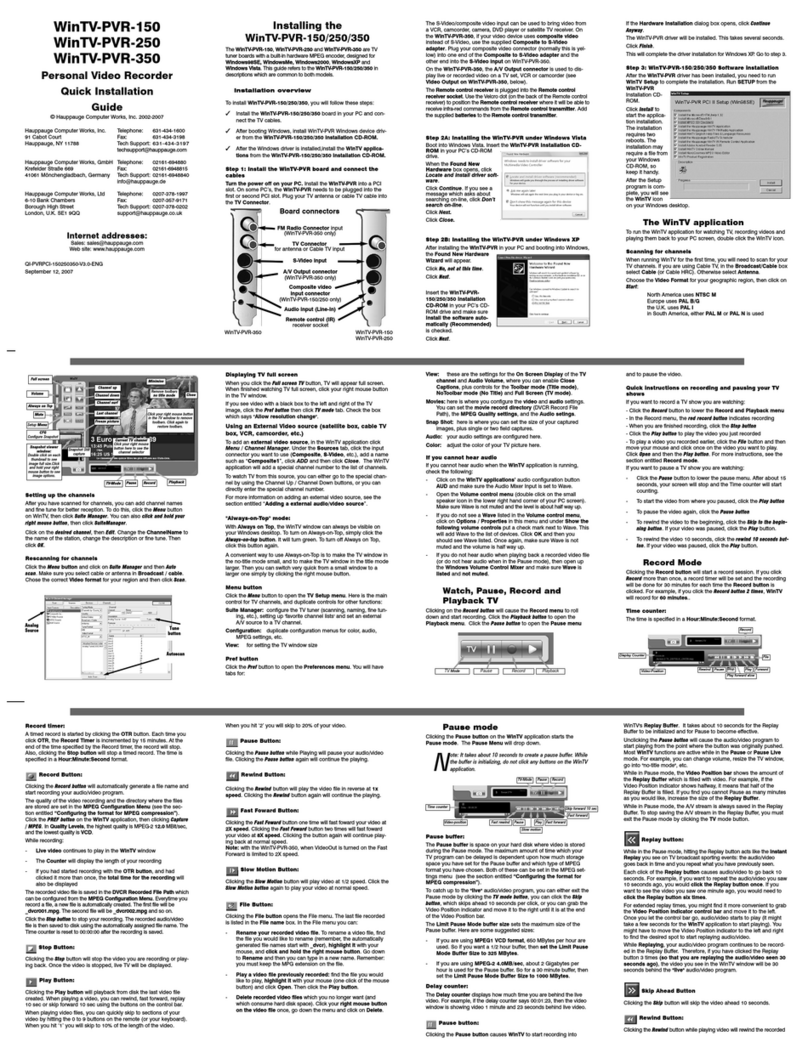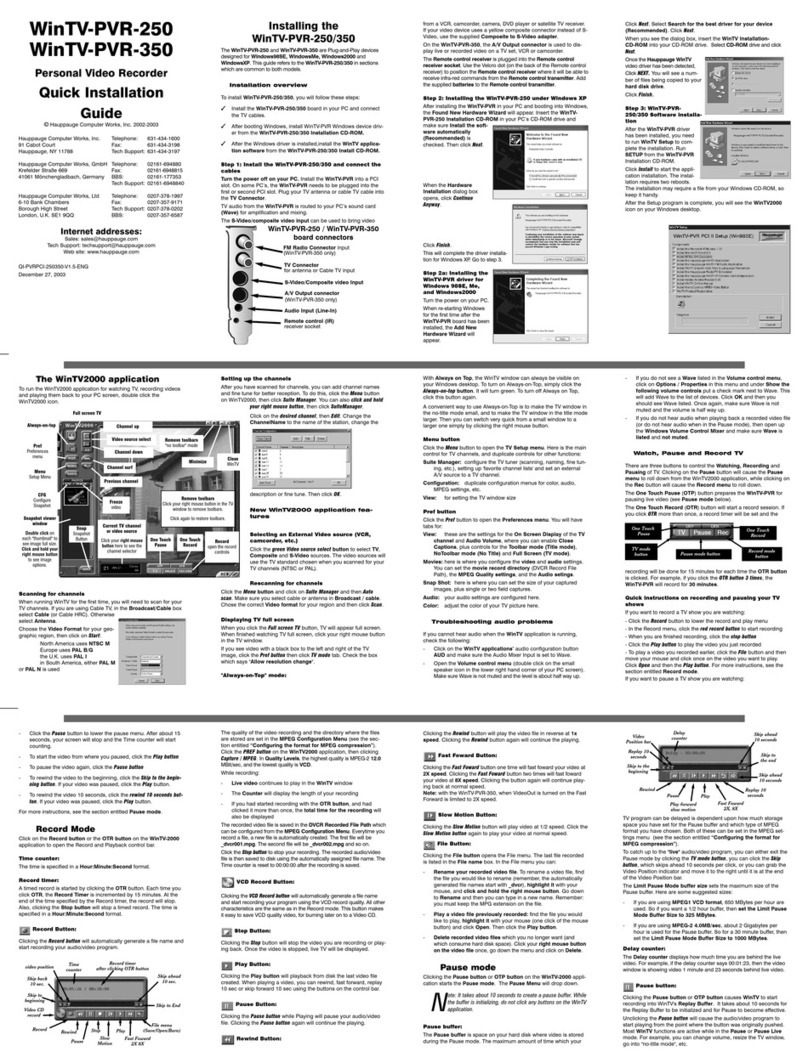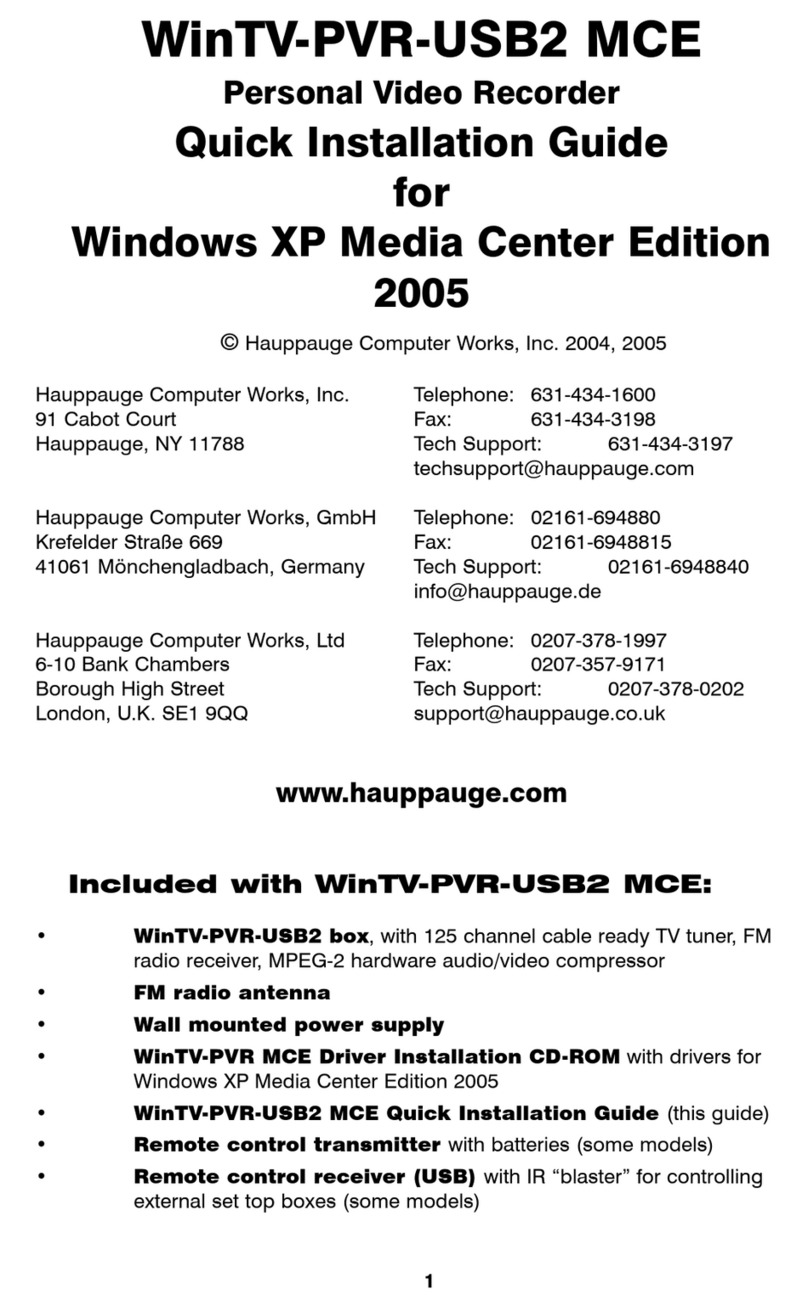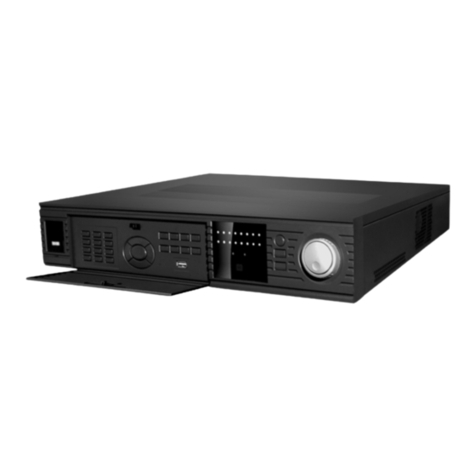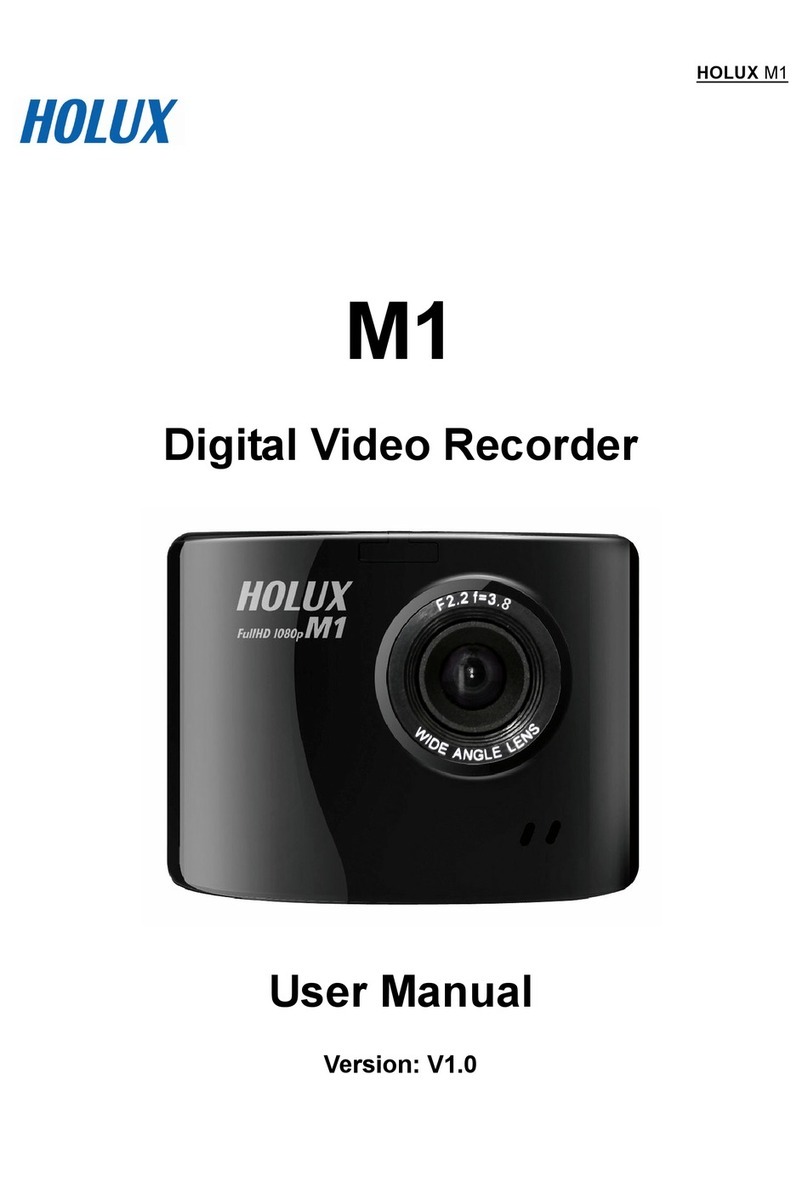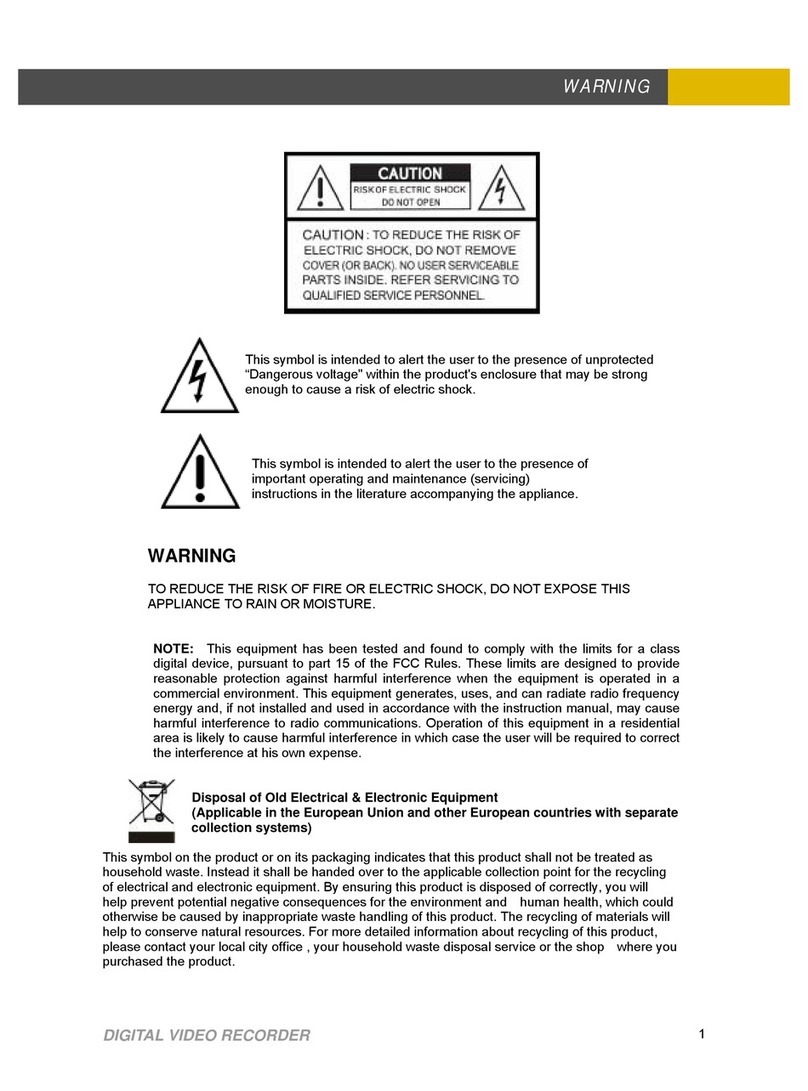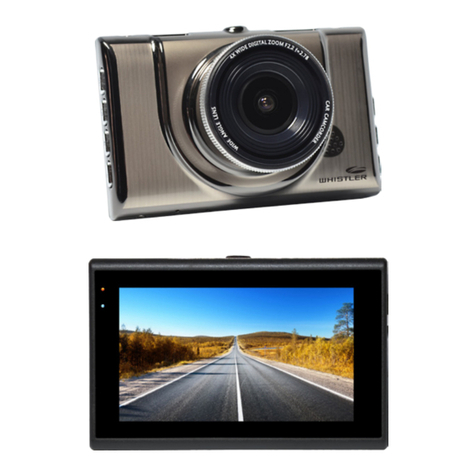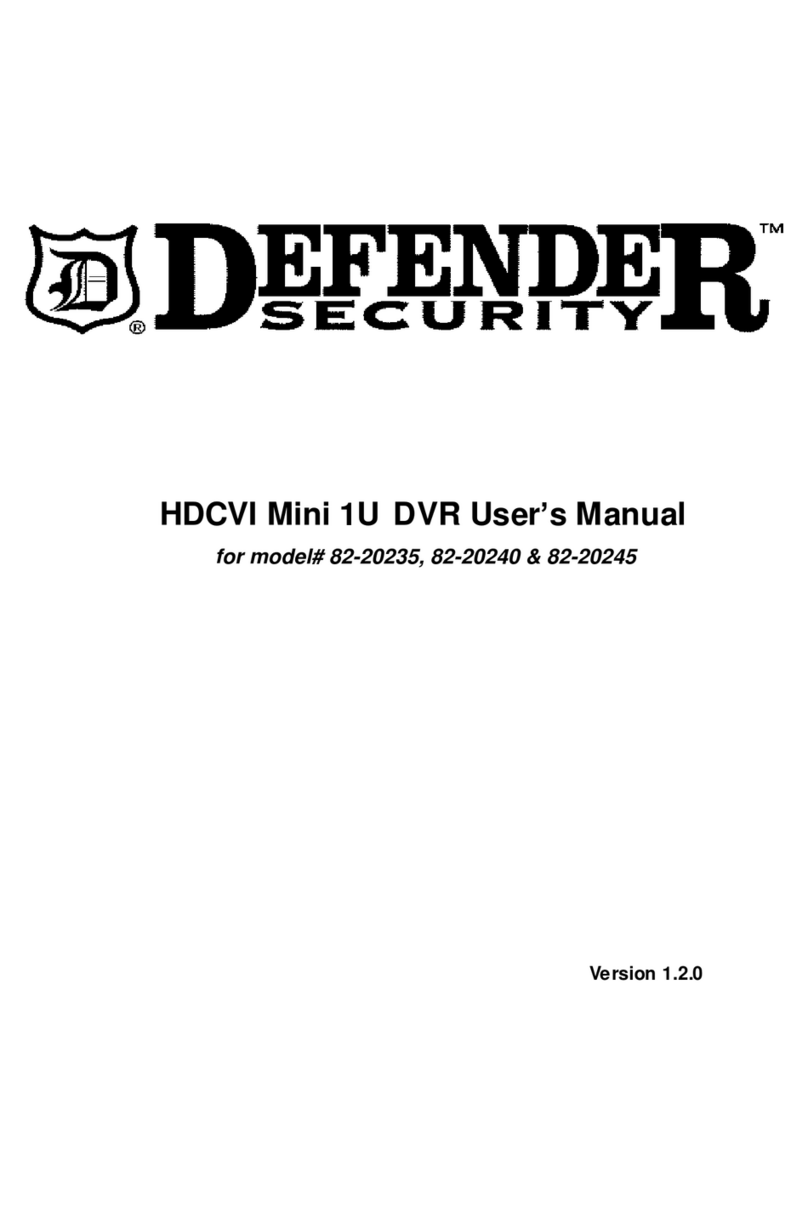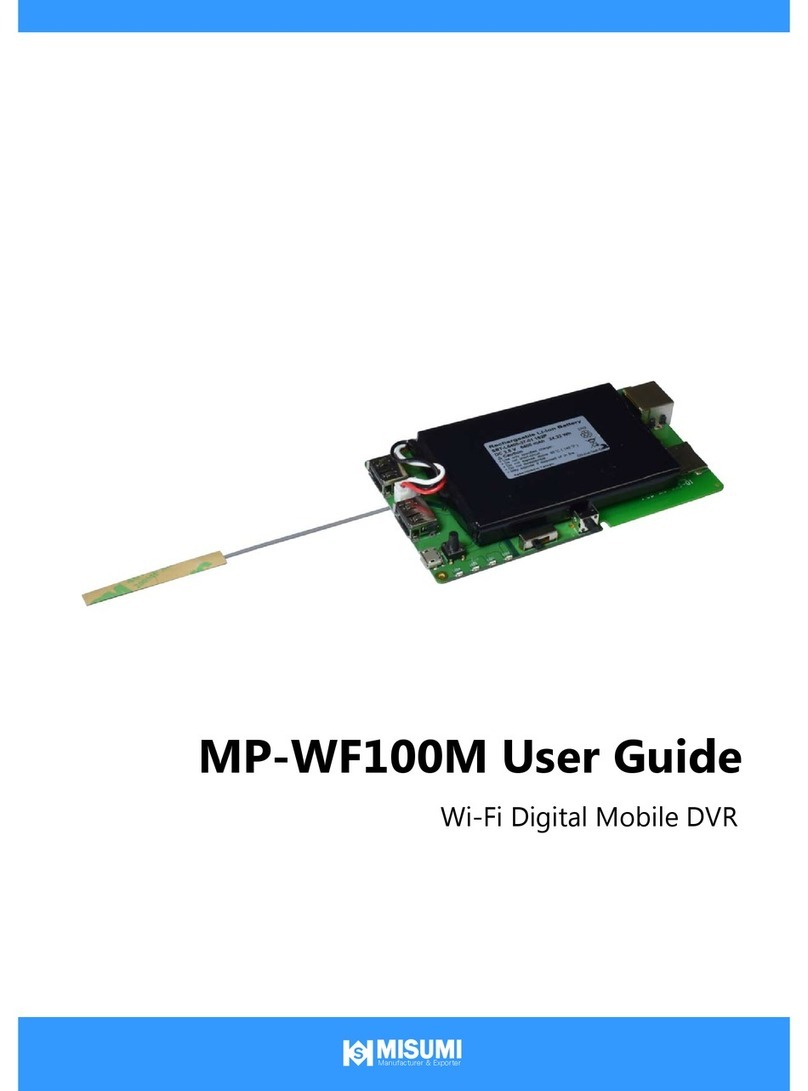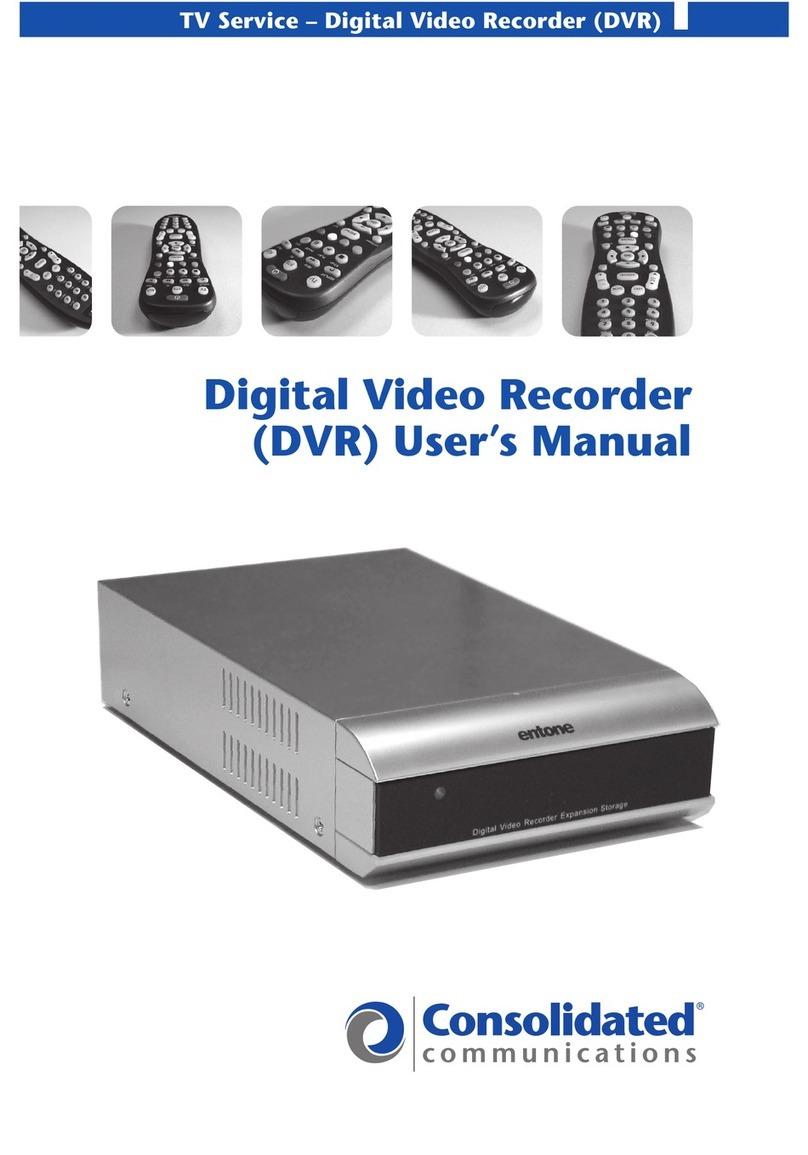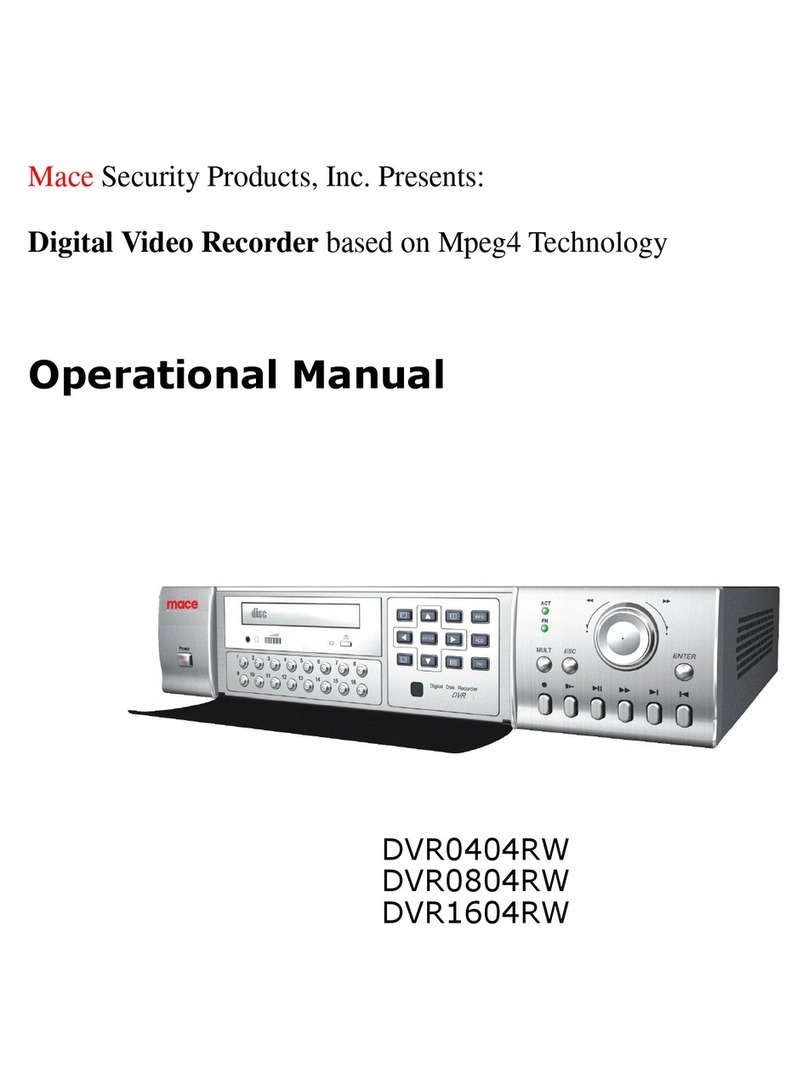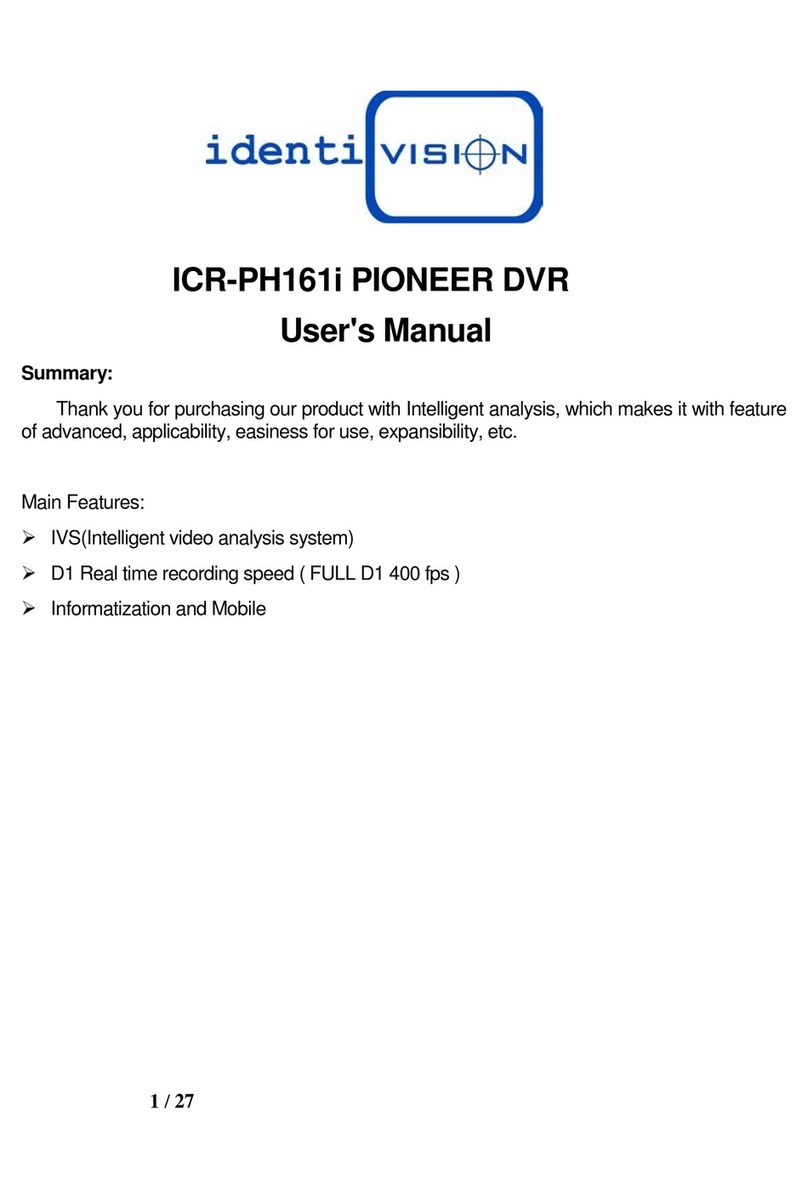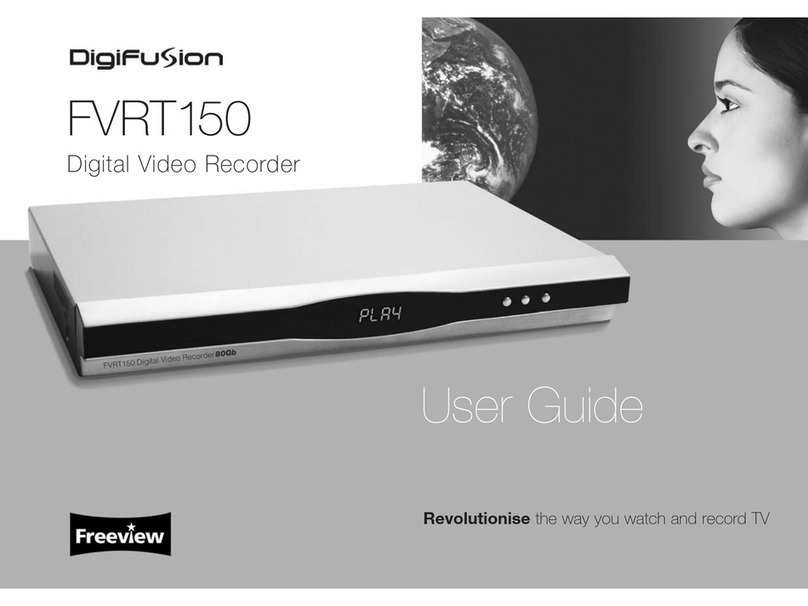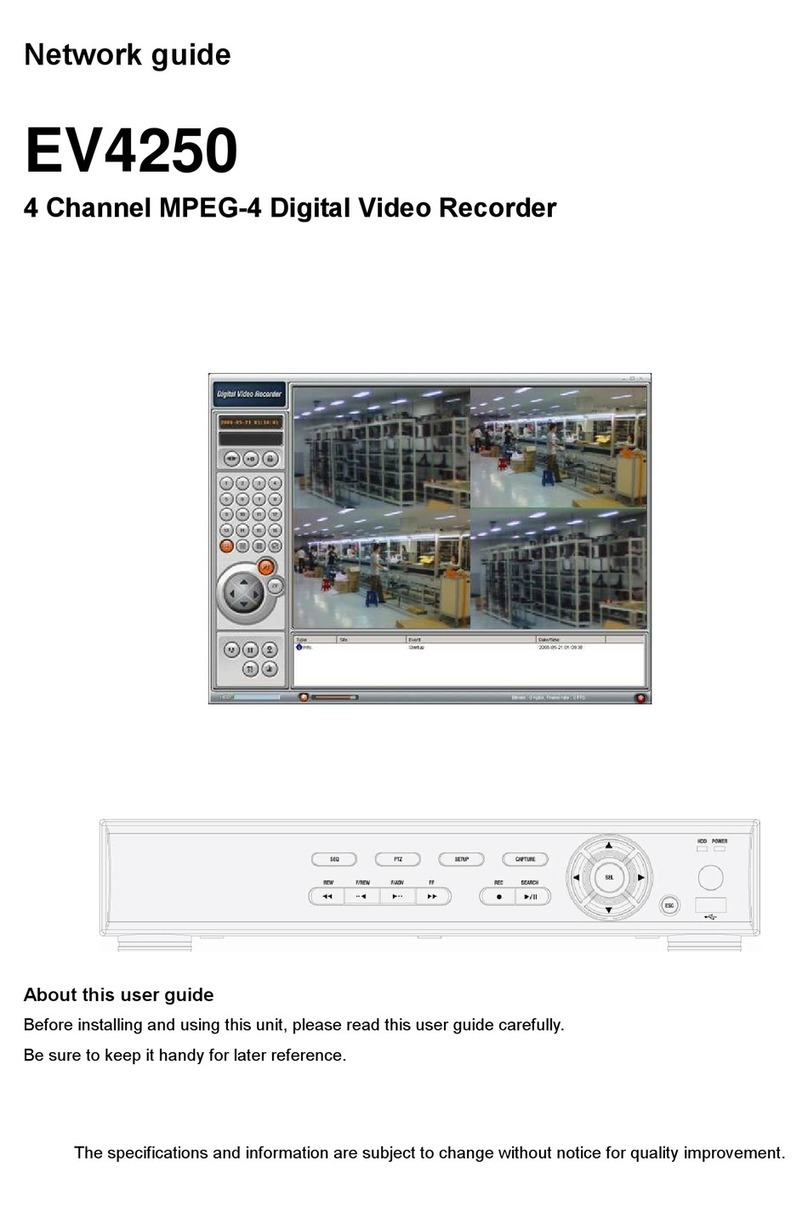Installing the WinTV-PVR-usb
The WinTV-PVR-usb is a USB device designed for Microsoft®
Windows98, WindowsME, Windows2000 and WindowsXP.
Installation overview
To install WinTV under Windows98, WindowsMe, Windows2000 or
Windows XP, follow these steps:
✓Plug the supplied Power Supply into WinTV-PVR-usb’s power
input.
✓Plug your TV antenna or cable TV cable into the WinTV-PVR-
USB's TV Connector.
✓Boot your PC. After Windows is running, plug the supplied USB
cable into the WinTV-PVR-usb and into one of your PC’s USB
ports. The Windows Hardware Wizard will then load the
WinTV-PVR-usb driver from the WinTV-PVR-usb Installation
CD-ROM.
✓After the WinTV-PVR-USB driver is installed, install the WinTV
application software from the Installation CD-ROM.
Step 1: Connect the WinTV-PVR-usb cables
Plug the supplied Power Supply into the Power Supply input. Plug
your TV antenna or cable TV cable into the WinTV-PVR-usb’s TV
Connector.
Plug the supplied Radio aerial into the FM radio connector. This
may not be necessary if your TV aerial or cable network supplies FM.
Plug one end (the square end) of the supplied USB cable into the
WinTV-PVR-usb’s USB Cable connector. DO NOT PLUG THE
OTHER END INTO YOUR PC UNTIL IT HAS COMPLETELY BOOTED!
The S-Video and Composite video inputs and the L&R audio inputs
can be used to bring audio/video from a VCR, camcorder, DVD play-
er or satellite TV receiver.
Step 2a: Installing the WinTV-PVR-usb driver for
Windows XP and Windows2000
After booting into
Windows, plug the
WinTV-PVR-usb in your
USB port. The Found
New Hardware Wizard
will appear. Insert the
WinTV Installation CD-ROM in your PC’s CD-ROM drive and make
sure Install the software automatically (Recommended) is
checked. Then click NEXT.
When the Hardware Installation dialog box opens, click Continue
Anyway. Click Finish.
This will complete the driver installation for Windows XP. Now go to
step 3 to install the WinTV-PVR applications.
Step 2b: Install the WinTV driver for Windows98SE,
WindowsMe
Boot your PC. When it is completely booted, plug the other end flat
rectangular end) of the supplied USB cable into your PC’s USB port.
When you plug in the WinTV-PVR-usb the first time, the Add New
Hardware Wizard will
appear. Click Next.
Select Search for the
best driver for your
device (Recommended).
Click Next.
When you see the dialog
box, insert the WinTV
Installation-
CD-ROM into your CD-
ROM drive.
Select CD-ROM drive and click
NEXT. It normally takes 10
seconds or so for the CD-ROM
drive to spin up. If Windows
cannot find the Hauppauge
WinTV video driver, the CD
had not yet spun up, so click
Back and then Next again.
Once the Hauppauge WinTV
video driver has been detected, click NEXT. You will see a number of
files being copied to your hard disk drive.
Click FFIINNIISSHH.
Now go to step 3 to install the WinTV applications.
Step 3: WinTV-PVR-usb Software installation
To start the WinTV-PVR software installation, click Start / Run then
type your CD-ROM drive letter (for example: E:\) and then
Setup.exe.
Chose a language,
and click Next.
The standard applica-
tions are selected,
ready to be installed.
Click Install to start
the application instal-
lation.
After the Setup program is complete, you will need to reboot your
PC. After rebooting, you will see the WinTV2000 icon on your
Windows desktop.
The WinTV2000 application
Running WinTV for the first time
When running WinTV-PVR-usb for the first time, you will need to
scan for your TV channels.
Choose the Video Format for your geographic region:
North America uses NTSC(M)
Europe uses PAL B/G
U.K. uses PAL I in South America, either PAL M or PAL N is used.
If you are using Cable TV, in
the Broadcast/Cable box
select Cable. Otherwise select
Antenna.
Then click on Start.
Setting up the channels
After you have scanned for
channels, you can add chan-
nel names and fine tune for
better reception. To do this,
click on the Channel configu-
ration button (Suite) in the
WinTV2000 application. Then click on the desired channel, then Edit.
Change the Channel Name to the name of the station. Fine tune if
necessary. Then click OK.
To set up an External video source
Click on the Channel configuration button (Suite) in the
WinTV2000 application and click Add. Click Composite or S-Video.
Pick your video format (NTSC for North and South America, PAL for
Europe, etc.) and give it a name (for example: external), then click
Add and then OK. Now you have a external video channel.
To change to External video, either select the channel name you
just configured, or click the Switch Video Source button on the
WinTV2000 application.
Rescanning for channels
If later on you want to re-scan channels, click on the Channel config-
uration button (Suite) and then Auto scan. Make sure you select
cable or antenna in Broadcast / cable. In the U.S. if you scanned
using cable and only received a few channels, try rescanning, but use
Cable (HRC) instead.
Chose the correct Video format for your region and then click Scan.
Tips on using WinTV2000
To watch TV without the WinTV toolbar:
Click your right mouse button in the WinTV’s video window to
remove the toolbar and leave just the TV window (“no-title” mode).
You can change channels in the no-title mode by typing a number or
by hitting the +/-keys. To adjust the audio volume, hit PgUp/PgDn,
or CTRL-M to mute the audio. To restore the toolbars (“title mode”),
click your right mouse button in WinTV’s video window.
You can set the window size and position differently in each mode.
“Always-on-Top” mode
With the Always on Top mode, the WinTV window can always be
visible on your Windows desktop, so that you can see you favorite
TV show while working on your PC.
To turn on Always-on-Top, simply click and hold your right mouse
button in the WinTV’s video window. Then click on Options and
click on Always-on-Top. A convenient way to use Always-on-Top is
to make the TV window in the no-title mode small, and to make the
TV window in the title mode larger. Then you can switch very quick
from a small window to a larger one simply by clicking the right
mouse button.
Allowing WinTV to display TV full screen
Click on the Pref button in WinTV2000 then click TV mode, and
check the box which says “Allow resolution change”. When you
click the Full screen TV button on WinTV2000, Windows will
change your screen resolution to either 640x480 or 800x600, and TV
will appear full screen. When finished watching TV full screen, click
your right mouse button to return to “TV-in-a-window” mode.
Watch TV, Pause and Record
There are three buttons to control the Watching, Recording and
Pausing of TV. Clicking on the Pause or Record buttons will cause
the Pause mode and Record mode menu’s to be displayed.
The One Touch Pause button prepares the WinTV-PVR-usb for
pausing live video (see Pause mode below).
The One Touch Record button will start a record session. If you
click OTR more than once, a record timer will be set, and the record-
ing will be done for 15 minutes for each time the OTR button is
clicked. For example, if you click the OTR button 3 times, the WinTV-
PVR-usb will record for 30 minutes.
Troubleshooting audio problems
If you cannot hear audio when the WinTV application is running,
check the following:
- Click on the WinTV applications’ audio configuration button
AUD and make sure the Audio Mixer Input is set to Wave.
- Open the Volume control menu (double click on the small
speaker icon in the lower right hand corner of your PC screen).
Make sure Wave is not muted and the level is about half way up.
- If you do not see a Wave listed in the Volume control menu,
click on Options / Properties in this menu and under Show the
following volume controls put a check mark next to Wave. This
will add Wave to the list of devices. Click OK and then you
should see Wave listed. Once again, make sure Wave is not
muted and the volume is half way up.
- If you do not hear audio when playing back a recorded video file
(or do not hear audio when in the Pause mode), then open up
the Windows Volume Control Mixer and make sure Wave is
listed and not muted.
Record Mode
Click on the Record button on the WinTV2000 application to open
the Record and Playback control bar:
Time counter
The time is specified in a Hour:Minute:Second format. When Recording,
the time of the recording will be displayed. On playback, the current posi-
tion time and the total time in the video being played will be displayed.
Record button:
Clicking the Record button will automatically generate a file name
and start recording your audio/video program. The quality of the
video recording and the directory where the files are stored are set in
the MPEG Configuration Menu by clicking the PREF button /
Capture / MPEG (see the section entitled “Configuring the format
for MPEG compression”) .
Note: it takes about 20 seconds for the recorder to
initialize. Do not click any WinTV buttons while the
record mode is initializing.
While recording:
- Live video continues to play in the WinTV window
- The Counter will display the length of your recording
- If you had started recording with the OTR button, and had
clicked it more than once, the total time for the recording will be
displayed
The recorded video file is saved in the DVCR Recorded File Path
which can be configured from the MPEG Configuration Menu.
Everytime you record a file, a new file is automatically created. The first
file will be _dvcr001.mpg. The second file will be _dvcr002.mpg and
so on.
The quality of the recording is configured from the MPEG
Configuration Menu (see the section entitled “Configuring the for-
mat for MPEG compression”). There are several video qualities: VCD
plus MPEG-2 2.0, 4.0, 6.0 MBit/sec, etc. The highest quality is MPEG-2
6.0 MBit/sec, and the least is VCD.
Clicking the Stop button will stop your recording, and then saves the
recorded audio/video file to disk using the automatically assigned file
name. The Counter will be reset to 00:00:00 after the file is saved.
VCD Record button:
Clicking the VCD Record button will automatically generate a file
name and start recording your audio/video program using the VCD
record quality. This button makes it easy to save VCD quality video,
for burning later on to a Video CD (CD-R or CD-RW). To burn a
Video CD, see the section entitled “Creating Video CD’s”.
Stop button:
Clicking the Stop button will stop the video you are recording or
playing back. Once the video is stopped, live TV will be displayed in
the WinTV window.
Play button:
Clicking the Play button in Record mode will play the last video file
created. When playing back a video, you can rewind, fast forward,
replay 10 sec or forward 10 sec using the buttons on the time slider.
Pause button:
Clicking the Pause button while Playing will pause your audio/video
file. Clicking the Pause button again will continue the playing.
Rewind button:
Clicking the Rewind button while playing will play the video file in
reverse at 1x speed. Clicking the Rewind button again will continue
the playing.
Fast Forward button:
Clicking the Fast Forward button one time will fast forward your
video at 2X speed. Clicking the Fast Forward button two times will
fast forward your video at 8X speed.
Slow Motion button:
Clicking the Slow Motion button while playing will play the video in
Slow Motion. To start playing your video file at the normal speed,
click the Slow Motion button again.
File button:
Clicking the File button opens the File menu. The last file recorded
is listed in the File name box.
In the File menu you can:
- Rename your recorded video file. To rename a video file,
find the file you would like to rename (remember, the automati-
cally generated file names start with _dvcr), highlight it with
your mouse, and click and hold the right mouse button. Go
down to Rename and then you can type in a new name.
Remember: you must keep the MPG extension on the file.
-Play a video file previously recorded: find the file you would
like to play, highlight it with your mouse (one click of the mouse
button) and click Open. Then click the Play button.
- Delete recorded video files which you no longer want (and
which consume hard disk space). Click your right mouse but-
ton on the video file once, go down the menu and click on
Delete.
-Burn your recorded video file onto CD-RW media in a Video
CD format. If you want to burn the last file recorded, simply
click Burn. If you want to select another file to be burnt onto CD-
ROM, highlight it with your mouse (one click of the mouse but-
ton) then click Burn. For more complete instructions, see the
section entitled Creating Video CD’s.
Pause mode
Clicking the Pause button on the WinTV2000 application starts the
Pause mode. The Pause Menu will drop down.
Note: It takes about 20 seconds to create a pause
buffer. While the buffer is initializing, do not click any
buttons on the WinTV application.
Pause buffer:
The Pause buffer is a circular buffer on your hard disk. The maxi-
mum amount of time which your TV program can be delayed is
dependent upon how much storage space you have set for the
Pause buffer and which type of MPEG format you have chosen. Both
of these can be set in the MPEG settings menu (see the section enti-
tled “Configuring the format for MPEG compression”).
The Limit Pause Mode buffer size sets the maximum size of the
Pause buffer. Here are some suggested sizes:
- if you are using MPEG-1 - VCD format, 650 MBytes per hour
are used. So if you want a 1/2 hour buffer, then set the Limit
Pause Mode Buffer Size to 325 MBytes.
- if you are using MPEG-2 4.0MB/sec, about 2 Gigabytes per
hour is used for the Pause buffer. So for a 30 minute buffer, then
set the Limit Pause Mode Buffer Size to 1000 MBytes.
Delay counter:
The Delay counter displays the amount of time the video window is
currently delayed from live video. For example, if the delay counter
says “00:01:23”, then the video window is showing video 1 minute
and 23 seconds behind live video.
Pause button:
Clicking the Pause button causes WinTV to start saving a audio and
video stream (referred to as an A/V stream) into the WinTV's Replay
Buffer. It takes about 15 seconds for the Replay Buffer to be initial-
ized and for Pause to become effective.
Unclicking the Pause button will cause the audio/video program to
start playing from the point where the button was originally pushed.
Most WinTV functions are active while in the Pause or Pause Live mode.
For example, you can change volume, resize the TV window, go into "no-
title mode", etc. If you are in the Pause mode though, the video image in the
WinTV window is frozen so you will not see the function change. For exam-
ple, in Pause mode if you change volume you will not hear the volume
change.
While in Pause mode, the Video Position bar shows the amount of
the Replay Buffer which is filled with video. For example, if the
Video Position indicator shows halfway, it means that half of the
Replay Buffer is filled. If you find you cannot Replay or Pause as
many minutes as you would like, there is a setting in the Preferences
menu where you can increase the size of the Replay Buffer.
While in Pause mode, the A/V stream is always saved in the Replay
Buffer. To stop saving the A/V stream in the Replay Buffer, you must
exit the Pause mode by clicking the TV mode button.
Replay button:
While in the Pause mode, hitting the Replay button acts like the Instant
Replay you see on TV broadcast sporting events: the audio/video goes
back in time and you repeat what you have previously seen.
Each click of the Replay button causes audio/video to go back 10
seconds. For example, if you want to repeat the audio/video you saw
10 seconds ago, you would click the Replay button once. If you
want to see the video you saw one minute ago, you would need to
click the Replay button six times.
For extended replay times, you might find it more convenient to grab
the Video Position indicator control bar and move it to the left.
Once you let the control bar go, audio/video starts to play (it might
take a few seconds for the WinTV application to start playing). You
S-Video
input
Composite
video input
WinTV-PVR-usb connectors
Freeze
Configure
snapshot
Color/Audio
configuration
Preferences
menu
Remove toolbar
Full screen TV
Minimize Close WinTV
Switch video
source
Snapshot viewer window -
double click on each
“thumbnail” to see image
full size
Current TV channel or
video source
Click your right mouse button
here to remove toolbars. Click
again to restore toolbar.
Click and hold your right mouse
button to see the OOppttiioonnssmenu.
Snapshot button
One Touch
Pause
One Touch
Recording
Record Mode
Pause Mode
TV Mode
Channel configuration
Mute audio
WinTV-PVR-usb
Personal Video Recorder
Quick Installation
Guide
©Hauppauge Computer Works, Inc. 2001-2002
Hauppauge Computer Works, Inc. Telephone: 631-434-1600
91 Cabot Court Fax: 631-434-3198
Hauppauge, NY 11788 Tech Support: 631-434-3197
Hauppauge Computer Works, GmbH Telephone: 02161-694880
Krefelder Straße 669 Fax: 02161-6948815
41061 Mönchengladbach, Germany Tech Support: 02161-6948840
Hauppauge Computer Works, Ltd Telephone: 0207-378-1997
6-10 Bank Chambers Fax: 0207-357-9171
Borough High Street Tech Support: 0207-378-0202
London, U.K. SE1 9QQ BBS: 0207-357-6587
Hauppauge Digital Asia, Pte. Ltd. Telephone: +65-276-9163
Blk 1093, Lower Delta Road #04-05 Fax: +65-276-9167
Tiong Bahru Industrial Estate Tech Support: +65-276-4412
Singapore 169204
Internet addresses:
Web site: www.hauppauge.com
QI-PVRUSB-V1.4a-ENG January 3, 2003
Pause mode button
TV mode
button
One Touch
Pause
One Touch
Record
Record mode
button
Left &Right
Audio Inputs
Record Play
Pause
Stop
File menu
(Save/Open/Burn)
Time counter
Skip to End
Skip back
10 sec.
Video CD
record
video position
bar
Fast Forward 2X
8X
Slow Motion
Rewind
Skip ahead
10 sec.
Skip to
beginning
Pause
Skip ahead 10
seconds
Replay 10
seconds Skip to the
end
Skip to the
beginning Skip ahead 10
seconds
Replay 10
seconds
Delay
counter
Video Position
bar
Play
Play forward slow
motion
Fast Forward 2X,
8X
Rewind
FM radio
connector
TV Connector
for antenna or
Cable TV
USB Cable
Connector
Power Supply input
